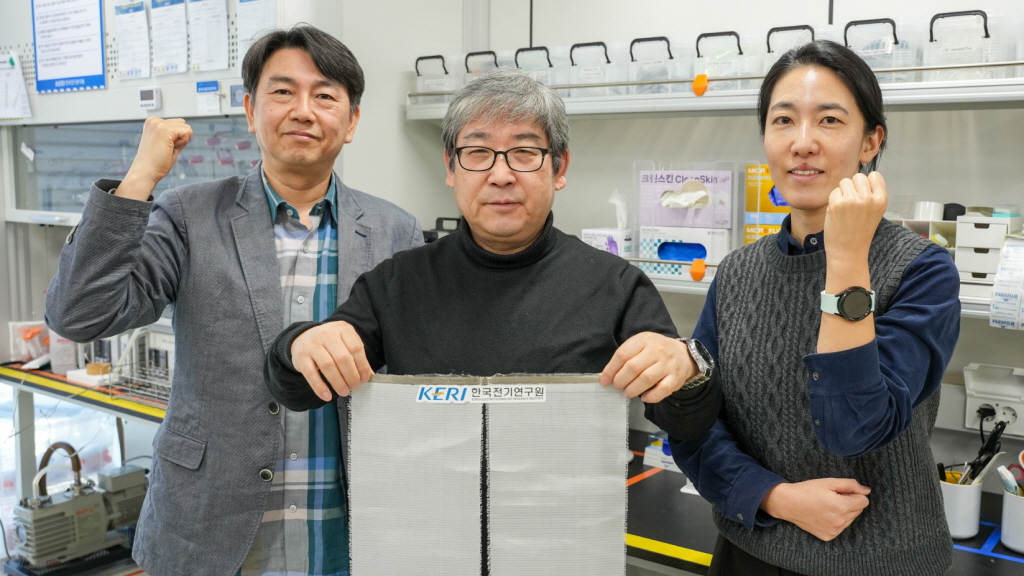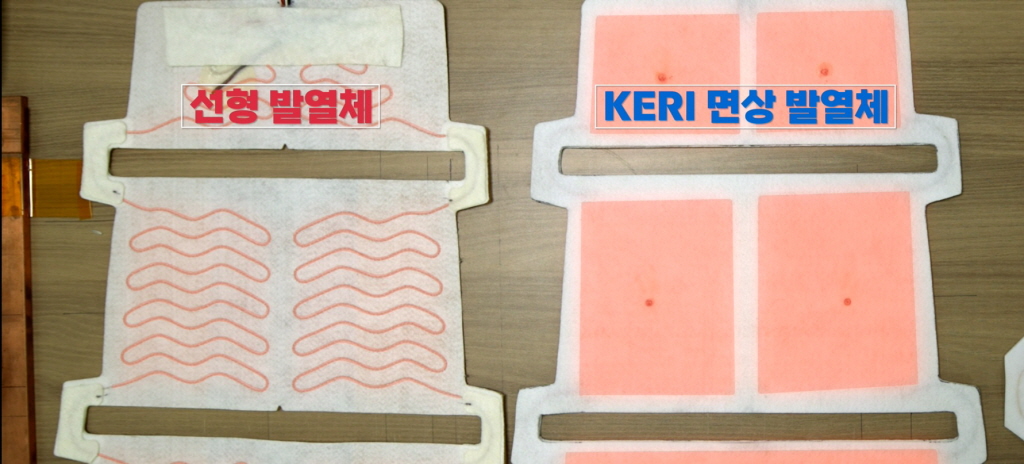한국전기연구원(KERI) 전기변환소재연구센터 이동윤 박사팀이 추위에 약한 전기차의 단점을 보완할 수 있는 고효율·고유연 ‘금속섬유천 면상 발열체’ 기술을 개발하며, 전기차의 에너지 절감을 위해 사용되는 복사열 난방 시스템에서 기존 소재의 문제점을 개선해 향후 자동차를 비롯해 반도체 등 제조 분야에서 활용이 높을 것으로 기대가 모아진다.

▲KERI 이동윤 박사(가운데)팀
균일한 열 분포 및 높은 내구성·효율성 강점, 반도체 등 제조 분야 활용
전기차의 에너지 절감을 위해 사용되는 복사열 난방 시스템에서 기존 소재의 문제점을 개선한 새로운 소재 기술이 개발돼 향후 자동차를 비롯해 반도체 등 제조 분야에서 활용이 높을 것으로 기대가 모아진다.
한국전기연구원(KERI)은 전기변환소재연구센터 이동윤 박사팀이 추위에 약한 전기차의 단점을 보완할 수 있는 고효율·고유연 ‘금속섬유천 면상 발열체’ 기술을 개발했다고 14일 밝혔다.
흔히 겨울철에는 배터리 성능이 떨어지고 차량 실내 온도 조절에 따른 에너지 소비도 많아 전기차의 전비(kWh당 주행거리)가 나빠진다.
‘미국환경보호청(EPA)’은 영하 7도의 환경에서 전기차 전비가 34% 떨어졌고, 주행거리도 상온(영상 24도)과 비교해 57%나 줄어든다는 결과를 발표하기도 했다.
전기차 성능 향상에서 자주 고려되는 항목이 바로 열 관리 시스템이다.
내연 기관차는 엔진의 폐열을 열원으로 활용해 난방 등 실내 온도 조절을 할 수 있다.
반면에 전기차는 폐열이 부족해 히터 등을 위한 별도의 시스템이 필요하고, 이는 곧 주행거리 감소로 이어지곤 했다.
이를 위해 많은 연구진이 전기차의 전기 장치에서 발생해 낭비되는 열 일반적으로 전기차의 동력 전달 과정에서 전기 에너지 중 약 20%가 열 에너지로 사라진다.
따라서 전기차의 가장 큰 숙제는 낭비되는 열을 관리 및 활용함으로써 전비를 향상시키려는 노력을 기울이고 있다.
그중에서도 국내 굴지의 자동차 그룹이 전통 온돌 방식에서 영감을 받아 목표로 제시한 ‘복사열 난방 시스템’은 전기를 받으면 열을 내는 ‘발열체’를 차량 실내 면적에 적용하여 전기차의 에너지 절감에 크게 기여할 것으로 주목받는 기술이다.
기존 난방 방식 대비 적정 온도 도달에 필요한 에너지 소모는 줄이면서, 보온 효과는 더 오래 가는 시스템으로, 동절기 전기차의 주행거리 단축 문제를 해결할 수 있다.
현재 발열체로는 ‘과전류보호소자(PTC)’가 사용되는데, 빠른 난방과 자체 온도 조절 기능에 따른 과열 방지, 소형화·저소음의 장점을 가지고 있다.
반면에 부피가 크고 무거우며, 높은 전력을 소비하기 때문에, 전기차에 적용하는 데 많은 어려움이 있다.
이것을 대체하기 위해 발열선이나 카본을 이용한 발열체가 제시되고 있으나, 낮은 열 효율 또는 화재의 위험성이 있어 충분한 대안이 되지 못하고 있다.
이에 KERI 이동윤 박사팀은 과거 옷감형 태양전지, 발열 의류 기술을 개발한 노하우를 활용해 ‘금속섬유천 면상 발열체’ 기술을 제시했다.
이 기술은 실을 가로, 세로로 엮어내 천을 짜는 직조기(베틀)에서 시작한다.
높은 열 전도성과 내구성을 자랑하는 50μm(머리카락 굵기 절반 이하 수준)의 아주 가느다란 ‘스테인리스강 미세 와이어(SUS316L)’를 제직해 천을 만들고, 이것이 발열체로 적용될 수 있도록 세부 기술(절연층 및 전극 구성 등)을 복합적으로 적용했다. 그리고 여기에 전기를 흘리면 금속이 가진 내부저항에 의해 최대 500도까지 발열이 일어나게 되는 구조다.
금속섬유천은 선(line)이 아닌 넓은 면(space)의 형태를 가졌기에 온열 기능에서 고른 온도 분포를 보이고, 유연성도 뛰어나 차량 내부 곡면 어디에도 손쉽게 부착할 수 있다.
또한 같은 양의 전기를 발열체에 흘렸을 때 기존 열선 방식 대비 금속섬유천이 10∼30% 높은 발열 성능을 보이는 등 효율 측면에서도 우수하다. 무엇보다 섬유천의 특성상 사용 중에 단선이나 부분 손상이 발생해도 성능을 유지하며 안정적으로 발열한다는 큰 강점을 가지고 있다.
이러한 많은 장점으로 KERI 금속섬유천 면상 발열체는 전기차의 온돌형 바닥 난방을 실현할 최적의 기술로 평가받는다. 장시간 사용 시 실내가 건조해지는 공기 가열식 난방이 아닌, 복사열 방식으로 넓은 공간을 따뜻하게 함으로써 쾌적함을 제공한다.
뿐만 아니라 제조업(반도체 생산 장비 및 화학 플랜트 배관, 기계 발열장치 등), 생활용(안마의자, 전기담요, 레저용 난방기), 의료용, 군용 등 균일한 발열이 필요한 다수 산업군에 적용 가능한 전방위 적용 기술로, 가능성도 무궁무진하다.
연구팀은 이들 분야의 기업들이 금속섬유천 면상 발열체를 활용하면 10∼30% 에너지 절감 효과를 거둘 수 있을 것으로 판단하고 있다.
KERI 이동윤 박사는 “금속섬유는 실과 달리 뻣뻣하여 직조가 매우 어려웠는데, 직물 생산·가공 업체인 ㈜송이실업과 협업하여 오랜 노력 끝에 금속섬유 전용 직조기, 그리고 제직 패턴을 개발할 수 있었다”며 “금속섬유만으로 면 형태의 발열체를 제작한 건 세계 최초이며, 우리의 성과를 통해 기업들의 에너지 비용 절감과 범국가적 탄소중립 실현까지 기대할 수 있을 것”이라고 전했다.
특허 출원까지 완료한 KERI는 국내 최정상 반도체 대기업을 대상으로 금속섬유천 면상 발열체 표준화 테스트까지 통과하는 등 성능 검증을 마쳤다. 현재 5건의 기술이전을 완료했고, 추가로 전기차와 반도체 등 관련 수요 기업을 발굴하여 시제품 제작 및 기술이전을 추진한다는 목표다.

